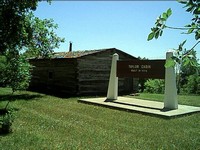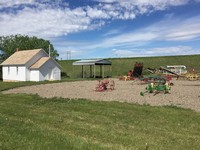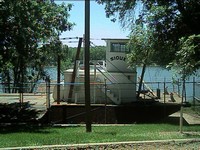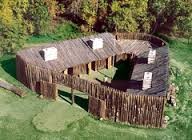Attractions & Exhibits
Joe Taylor Cabin
The original cabin of Joseph H. Taylor, one of Washburn's first residents, is still standing today in downtown Washburn.
Joseph Henry Taylor, a Quaker from Pennsylvania, was a trapper and hunter who was also scholarly and had a great interest in nature. He had served in the cavalry of the Union Army and one year as an Indian fighter.
He came to the Washburn area in 1869 and he staked his claim in 1871. He built his cabin at Painted Woods (15 miles south of Washburn) in 1869. A printer by trade, he wrote 4 books and numerous newspaper articles during his 40 years of pioneering in North Dakota. He was the editor of the Washburn paper, the McLean County Mail at the time of his death in 1908.
The Taylor Cabin was moved to Washburn in 1932 for Washburn's 50th Anniversary and for preservation and exhibit. It is located in the 1000 block of East Main Avenue, next to the Bunkhouse.
Nettle Creek School #1
Nettle Creek Schoolhouse was the first one-room schoolhouse built in McLean County, Dakota Territory.
It was built in July of 1883 at the cost of $400. The one-room country school was first constructed as a log cabin, with clapboard siding added to it later. The first term of school began November 6, 1883. It was originally located seven miles east of Washburn. The school was closed in 1949 and it was moved to its present location (Pioneer Park) in July of 1968. Mrs W.K. Williams (Mary Ann Barnes Williams) was instrumental in having the school moved into Washburn.
It was purchased from Oscar Doepke (Lechner farm) for $100 and moved at a cost of $300. Total repairs cost $1,268.19. The school was then deeded to the Mclean County Historical Society for preservation as a State Historical Building.
To the northwest of the School house are several pieces of old farm machinery that were in days gone by.
The Sioux Ferry
The Sioux is located along the Missouri River at Washburn's Riverside Park.
The Sioux Ferry was one of the last paddle-wheel ferries operate on the Missouri River. It was built by Oscar Anderson and took its maiden voyage on Memorial Day 1952, and operated until 1962. The ferry once transported horses, autos and people from bank to bank. For years, the Sioux provided the only means of getting across the wide Missouri between Washburn and Hensler. A person could go down to the riverbanks, pay a small fee and ride across. If Anderson was on the other side of the river, one just waved at him to bring the Sioux over. It was closed down because of navigation problems on the Missouri. The Garrison Dam caused major changes in the Missouri's channels.
The Sioux Ferry is on permanent display at the park.
A little History:
Oscar Anderson worked alone on the Sioux (1951-52). He did everything from laying the keel to installing the engine by himself. It was constructed primarily of Oregon Fir, specially ordered through the Washburn lumber yard. Power was supplied by a seventy-five horsepower diesel engine once used in an Alaskan fishing boat. The engine was shipped overland from Seattle, Washington. The Sioux is around sixty feet long, and is eighteen feet wide at the bottom. The deck is twenty-two feet by twenty-six feet, and had room for three automobiles. It was launched each Spring and operated through the all until cooling weather signaled time to put it in dry-dock just East of the present Riverside Park.
The Souix now stands as a monument to the colorful past of Washburn's riverboat era, and to the breed of men that era produced--men like Oscar Anderson.
Fort Mandan
Fort Mandan was the winter campsite of the Lewis and Clark Expedition in 1804-05.
In 1969, the McLean County Historical Society researched and built the Fort Mandan replica. This was the first project of the historical society. The money to build the fort was raised through local fund raising projects. Joe Thompson designed and engineered the building of the replica.
The re-construction of Fort Mandan was completed in 1972. It is in the general vicinity of the original campsite which was across the the river from the Mandan Indian villages where Fort Clark was later established. The location of the original fort which sheltered the 44 members of the expedition that winter of 1804-05 is not definitely known, but is believed to now be in the center of the restless Missouri River.
The replica of Fort Mandan is located 3 miles west of Washburn (on 8th Street SW)
The society owns the fort and operated it until 1997. The Society later leased Fort Mandan to the Lewis & Clark Bicentennial Foundation. The North Dakota Parks and Recreation Department took over the lease in 2015. The State Historical Society of North Dakota took over the lease in 2021.


 Joe Taylor Cabin
Joe Taylor Cabin Nettle Creek Schoolhouse
Nettle Creek Schoolhouse Sioux Ferry
Sioux Ferry Fort Mandan
Fort Mandan